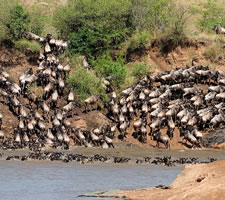
When is the Best Time to Visit Kenya?
Kenyan climate is perfect for your year-round African bush and beach holiday. The moderate to equatorial temperatures mean that you are comfortable during your daytime game drives and other outdoor activities. In the evenings and early mornings, you may only need a light jacket or warm fleece to fend off the slightly cooler temperatures in the Great Rift Valley highlands.
Temperatures and rainfall levels fluctuate throughout the year. Understanding the natural cycle of wet and dry seasons helps you plan the ideal East African safari and coastal explorations in Kenya based on your personal desires.
You shouldn’t think that the great migration experience is the best time to visit Kenya, the wildlife can be seen year-round, with babies being born towards the end of the year, and migratory bird species visiting from September to April. During the long rains from March to May, some accommodation may shut down, and travel can be tough.
Because Kenya is located on the equator, there is no real summer and winter. Instead, the year is divided into rainy and dry seasons. There are two dry seasons: a short one in late January and early February, and a much longer one lasting from late June to October.
The short rains fall in November and December, but by far the wettest season is the period from March to May. Temperatures are relatively consistent in each region of Kenya, but vary from one place to the next according to elevation. The coast, for example, is considerably hotter than the plateaus of central Kenya, while Mount Kenya is so high that it is permanently capped with snow.
The beginning of January right the way through to the end of February signals the warmest period to visit Kenya with higher concentrations of animals congregating in popular tourist destinations, such as the Masai Mara, Lake Nakuru and Amboseli. This is a great time of year for divers to go to Kenya as visibility in the Indian Ocean is much clearer thanks to the lack of surface run off.
Early March still has some blue skies although animals will already be in shorter supply due to the start of the rainy season which runs right through April and into May. Flooded roads, an abundance of vegetation and generally wet weather at this time makes for poor wildlife watching and slippery summits to Mount Kenya however, if you’re looking to bag a bargain then this is certainly a time of year worth bearing in mind.
June sees the start of Kenya’s dry season with waterholes and river banks teeming with animals and although prices will go up during July and August, being able to observe the wildebeest migration crossing the Masai Mara is well-worth a few extra Shillings.
With the school holidays out of the way in September you’ll find fewer visiting families and October through to November is a great time to go to Kenya if you’re not tied to the kids. December can be an excellent time to visit Kenya with lush green scenery making an ideal habitat for migratory birds and new born animals.

